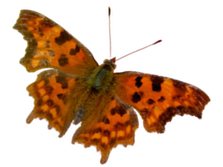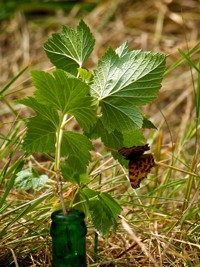Ongoing research
| The bigger picture | Mechanisms | The ecological interface |
Most of our research focuses on understanding the evolutionary dynamics of host plant range, host shifts, and speciation. And in particular how these phenomena are interrelated. This calls for a multidisciplinary approach that spans from phylogenetics to genetics, and from ecology to physiology.
The bigger picture
The parasite paradox
Early work by this and other groups have suggested that plant-feeding insects (including butterflies) are typically conservative specialists – they tend to stick to their diet of choice (e.g. Janz & Nylin 1998). However, when analyzing host plant utilization in the tribe Nymphalini in more detail, we found a bewildering number of host plant changes (see Janz et al. 2001) that were hard to reconcile with the "conservative specialist" axiom. Most of these changes were actually host colonizations without loss of the ancestral plants leading to increasingly wider host ranges (i.e. not host shifts), so that the net change in the group was clearly towards decreasing specialization. And with an estimated number of host use changes falling between 29 and 37 in a clade with 30 species it certainly wasn't conservative.
This is the parasite paradox (Agosta et al. 2010): parasites (broadly speaking, including many plant-feeding insects) appear to shift hosts much more often than they “should,” considering their highly specialized and conservative feeding habits.
A resolution
We have suggested a simple resolution for this paradox, but one that may have far-reaching consequences for the evolution of insect/plant systems (Janz & Nylin 2008; Agosta et al. 2010; Janz 2011). Basically, the reason that these insects shift hosts so often is that they don't, really. We noticed early on that a majority of the observed shifts tended to involve a small and recurring theme of plants. The simplest explanation for this pattern is that plants that are no longer used are not quite lost from the repertoire of the insect, and as a consequence can easily be picked up at a later time. This is also the reason for the more conservative pattern on lower levels of resolution; as most host shifts tend to involve the same set of plants, many of these shifts will "disappear" from the record with time (Janz et al. 2001). History will wipe its own path, so to say.
Further support for this explanation comes from the observation that polyphagy appears to be an ephemeral stage in host range evolution, and is much less phylogenetically conservative than the actual use of specific plant taxa (Nylin et al. 2014).
The oscillation hypothesis
The resolution to the parasite paradox was one of the major inspirations for the oscillation hypothesis for host-driven speciation. It is a multipart process that will, with time, result in elevated rates of speciation in lineages that undergo repeated changes in host range (Janz et al. 2006, Nylin et al. 2013).
First, a host range expansion comes with a potential increase in geographic range size. Causation can go both ways but there appears to be a general correlation (Slove & Janz 2011). Second, such widespread species are likely to experience increased population fragmentation, due to local adaptations or drift. Decreased gene flow and isolation can eventually lead to further fragmentation and eventually, speciation, whereby the cycle can start again (see Janz & Nylin 2008 and Nylin & Janz 2009 for more detailed explanations).
The geographic component of the oscillation hypothesis makes it interesting to unravel the geographic structure of species and populations. We have investigated the genetic structure of two sister species; the palearctic Polygonia c-album Kodandaramaiah et al. 2011 and the nearctic P. faunus Kodandaramaiah et al. 2012, which revealed strikingly different patterns of geographic structuring, suggesting that they are in different stages of the "oscillation cycle".
Mechanisms
What is host plant range?
The phylogenetic patterns suggest that host plant ranges are modular, so that the abilities to handle different plant groups can evolve more or less independently of each other. Work is currently underway in our lab to investigate the genetic basis of these plant "modules", their degree of overlap and phylogenetic conservatism. Indeed, a first study suggested that there are aspects of host use that are shared among plants that share both phylogenetic ancestry and growth form (Heidel-Fischer et al. 2009), but the genomic background of how host plant ranges are built up and maintained remains one of the most pressing issues to clarify. Are different plants in the repertoire handled by a small set of "generalized" gene products, or do the inclusion of a novel plant require a different set of genes?
A first key to answer this question came from a rearing experiments involving larvae of the polyphagous species Polygonia c-album feeding on two different hosts (Celorio-Mancera et al. 2013). The study revealed large transcriptomic differences between larvae feeding on different plants, suggesting that building an extended repertoire of host plants can be an evolutionary challenge.
Host plant choice
 Larval capabilities constitute one major part of the trait complex that eventually is manifested as host plant use. Another equally important part is female host preference. It can be argued that while the larval capabilities set the limits to the potential range that can be used, it is the female host plant selection that determines what plants are actually used at any particular point in time. We have previously shown that female host choice is a highly dynamic trait that can vary considerably between species and populations as well as between and within individuals (plasticity, learning). Furthermore, there are distinct differences in the speed and accuracy of oviposition choices between species and populations that vary in degree of specialization (see, for example, Nylin & Janz 1993; Janz et al. 1994; Nylin & Janz 1996; Janz & Nylin 1997, Janz 1998; Nylin et al. 2000; Janz 2003; Janz et al. 2009).
Larval capabilities constitute one major part of the trait complex that eventually is manifested as host plant use. Another equally important part is female host preference. It can be argued that while the larval capabilities set the limits to the potential range that can be used, it is the female host plant selection that determines what plants are actually used at any particular point in time. We have previously shown that female host choice is a highly dynamic trait that can vary considerably between species and populations as well as between and within individuals (plasticity, learning). Furthermore, there are distinct differences in the speed and accuracy of oviposition choices between species and populations that vary in degree of specialization (see, for example, Nylin & Janz 1993; Janz et al. 1994; Nylin & Janz 1996; Janz & Nylin 1997, Janz 1998; Nylin et al. 2000; Janz 2003; Janz et al. 2009).
However, the mechanisms behind host plant choice remains largely unknown. How do neural input from vision, olfaction, and gustation interact to elicit a choice to oviposit or not? How can the differences seen between specialists and generalists be explained physiologically?
Initial studies using optical imaging of the olfactory lobe have revealed that females can tell plant species (and single volatiles) apart by olfaction alone, and that a specialist species showed a more distinct pattern when exposed to its single host in relation to other plants than a generalist (Carlsson et al. 2011). Several projects in this context is underway, with the aim to understand how olfactory and other stimuli are integrated in the insect brain (e.g. Carlsson et al. 2013), and how these stimuli are translated into behavior.
In nature, sensory stimuli do not present themselves as unique compounds, but are perceived as an ensemble. Therefore, another important area of research is on how stimuli of different kinds can conflict or reinforce each other during the search process (e.g. Trona et al. 2013).
The ecological interface
 We are involved in the joint collaborative EkoKlim project at Stockholm University, an interdepartmental and interdisciplinary effort to investigate how climatic variation affects social and ecological processes across spatial and temporal scales. Our part of the project will investigate on how climate and land use affect the ecological dynamics of several nettle-feeding butterflies with different reaction norms for temperature as well as host specialization.
We are involved in the joint collaborative EkoKlim project at Stockholm University, an interdepartmental and interdisciplinary effort to investigate how climatic variation affects social and ecological processes across spatial and temporal scales. Our part of the project will investigate on how climate and land use affect the ecological dynamics of several nettle-feeding butterflies with different reaction norms for temperature as well as host specialization.
We have shown that the effect of a temperature increase on the degree of specialization in the comma butterfly is highly dependent on whether the increased temperature also leads to a shift from one generation to two (Audusseau et al. 2013).
